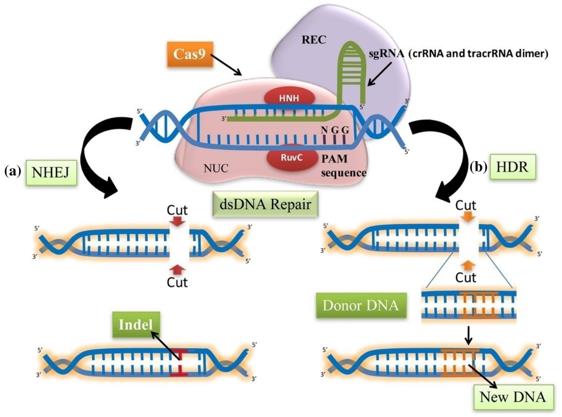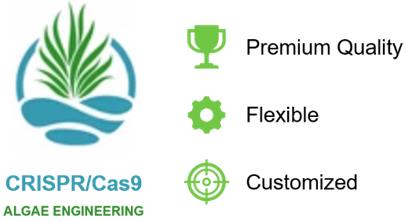CRISPR/Cas9 Service for Algae
The highly efficient CRISPR/Cas9-based system is a useful tool to conduct stable targeted gene engineering in the algae to create commercial strains for specific utilizations.
With our professional team and equipment, Lifeasible can promote your algae-related studies by CRISPR/Cas9 systems in different types of algae models.
The Importance of Genetic Engineering in Algae
Algae are an important source of commercially attractive and important products such as carotenoids, fatty acids, plant proteins, polyketides, pectins, and halogenated compounds. To fully exploit the potential of algae, a commercial strain of algae with high biomass turnover, rapid reproduction cycles, and high photosynthetic efficiency is required, which can be created through various genetic engineering tools.
Introduction to CRISPR/Cas9 System
The CRISPR/Cas9 machinery is an essential component of the adaptive immune system of bacteria and archaea, protecting cells from exogenous nucleic acids through sequence-dependent cleavage of foreign DNA. The system consists of the Cas9 protein guided by crispr-RNA, which binds to the target DNA, and tracr-RNA, in charge of stabilizing the complex and activating Cas9. For the purpose of application in genome editing, crispr-RNA and tracr-RNA are synthesized into single guide RNA (sgRNA).

The Mechanism of CRISPR/Cas9 System
The Cas9 protein has nuclease activity that leads to blunted double-stranded DNA breaks, which cleave the three nucleotides upstream of the PAM element, which is required for target recognition. Cas9 plays a role in crRNA processing by annealing with the target DNA and cleaving the target through its two nuclease structural domains RuvC and HNH. The HNH structural domain of Cas9 cleaves the DNA strand complementary to crRNA, whereas the RuvC-like structural domain cleaves the DNA strand opposite to the complementary strand.
 Fig.1 The schematic representation of the CRISPR/Cas9 mechanism. (Patel, V. K., et al., 2019, Molecular biotechnology)
Fig.1 The schematic representation of the CRISPR/Cas9 mechanism. (Patel, V. K., et al., 2019, Molecular biotechnology)
CRISPR/Cas9 System in Algae
CRISPR/Cas9 technology can be applied to efficiently create stable targeted gene mutations in a variety of microalgae species. In most algae engineering cases, the two components necessary for the system, the Cas9 nuclease and the guide RNA that directs the nuclease to specific DNA sequences, are expressed by the same vector.
Our Services
Lifeasible has a variety of models of different algal species capable of transient and stable expression of Cas9 protein and sgRNA for gene editing. We provide multiple CRISPR/Cas9-based genomic editing services for worldwide clients including but not limited to green algae like Chlamydomonas reinhardtii and Nannochloropsis sp., and model diatoms like Phaeodactylum tricornutum and Thalassiosira pseudonana.
![]() CRISPR/Cas9 Mediated Targeted Knock-out - The precise gene deletion can be obtained by both single sgRNA or two sgRNAs mediated CRISPR/Cas9 system.
CRISPR/Cas9 Mediated Targeted Knock-out - The precise gene deletion can be obtained by both single sgRNA or two sgRNAs mediated CRISPR/Cas9 system.
![]() CRISPR/Cas 9 Mediated Targeted Knock-in - The CRISPR/Cas9 system has been implemented for the targeted insertion of donor DNAs into algae genomes.
CRISPR/Cas 9 Mediated Targeted Knock-in - The CRISPR/Cas9 system has been implemented for the targeted insertion of donor DNAs into algae genomes.
![]() CRISPRa Mediated Gene Overexpression - CRISPRa uses an inactivated CRISPR-Cas9 system (dCas9) to upregulate target genes in algae.
CRISPRa Mediated Gene Overexpression - CRISPRa uses an inactivated CRISPR-Cas9 system (dCas9) to upregulate target genes in algae.
![]() CRISPRi Mediated Gene Repression - Epigenome Editing can be conducted based on the CRISPRi system. The target gene expression can be repressed by transforming stable RFP expressing cells with sgRNA and dCas9.
CRISPRi Mediated Gene Repression - Epigenome Editing can be conducted based on the CRISPRi system. The target gene expression can be repressed by transforming stable RFP expressing cells with sgRNA and dCas9.
Why Choose Us
Lifeasible has provided CRISPR/Cas9 services for algae genomic engineering for decades. We have accumulated a lot of experience and a large number of algal models of Cas9 protein expression. Please contact us for more information.

Reference
- Patel, V. K., Soni, N., Prasad, V., Sapre, A., Dasgupta, S., & Bhadra, B. (2019). CRISPR-Cas9 System for Genome Engineering of Photosynthetic Microalgae. Molecular biotechnology, 61(8), 541–561.
Our services are for research use only and not for any clinical use.